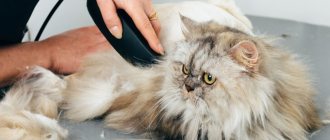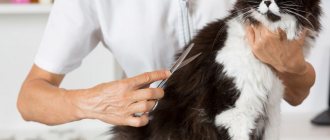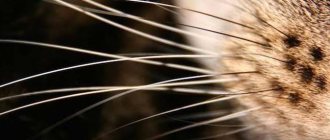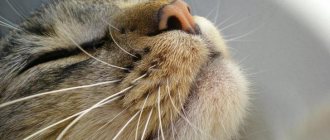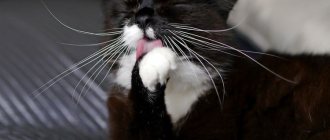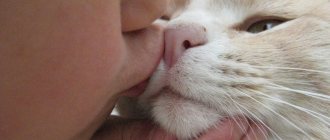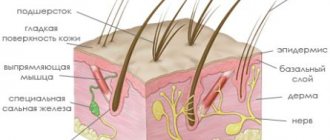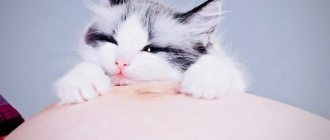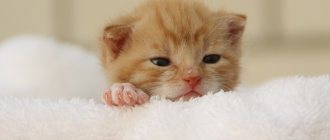In general, cats have many things that make people fall in love with them: soft paws, majestic whiskers and, of course, fluffy fur. This is why it can be frustrating to watch your cat continually shed hair at the base of her tail day after day. Without treatment, hair loss around the tail in cats often results in localized hair loss, which leaves the cat's coat in an unsightly condition. If you want to put an end to hair loss, you must identify the root cause and treat it as soon as possible.
Need help with your cat's tail hair loss problem? Then this article will really be useful to you. Below, you'll learn just about everything pet owners need to remember about cat hair loss, from causes to solutions. Use the following information you get here to help your kitten get his fur back.
Mr. Cat advises: what to do if your cat's fur falls out in clumps
The very first and most important thing is that as soon as you notice that your pet’s fur has lost its attractiveness, and clumps of fur have begun to appear more often on the floor, you need to contact a veterinarian.
Since the cause of baldness can be quite serious, even cancer, it is undesirable to hesitate. If there are wounds, ulcers, or lesions on the animal’s skin, blood tests and skin scrapings will be taken. This will allow you to quickly make the correct diagnosis and prescribe treatment. It is difficult, almost impossible, to completely get rid of atopic dermatitis, since allergens are contained in the environment, that is, in the air. Only a strict diet and special medications will help maintain your cat’s health.
To cut or not to cut your pet?
During a grooming, a cat gets stressed, which can lead to unpleasant consequences. However, the determining factor is the climate in which you live and where the pet spends most of its time - outdoors or indoors. When it's very hot outside and you want to help your four-legged friend, a haircut won't be a bad idea. Despite the obvious benefits (especially for long-haired cats), clipping has some disadvantages. A trimmed animal adapts less well to temperature changes. Cats walking outside can overheat in the sun, since their skin will not be protected by fur, and the pet can catch a cold. Therefore, you should not get carried away with this procedure. It is necessary to organize proper coat care, in this way you can avoid the formation of tangles and, as a result, the occurrence of skin diseases.
Causes and symptoms
Healthy hair in cats is shiny, smooth, with strong hair follicles. With the development of disorders in the body, alopecia may occur. Its areas can be symmetrical, with complete or partial hair loss.
Even an inexperienced owner will notice problems with a pet’s fur, since there will be large quantities of it around the apartment. You can try to determine the cause of the appearance of bald patches.
With some diseases, cats begin to scratch the affected area. If the violation is more serious, the skin begins to peel off, ulcers and scabs appear on it. Sometimes seals form.
The reasons why a cat's belly is going bald can be:
- allergic reaction to food or any of its components;
- prolonged stress state;
- mechanical damage;
- avitaminosis;
- hormonal disorders;
- liver pathologies;
- weakening of hair follicles;
- skin diseases of various types.
Allergy
Allergies appear in response to new foods, vitamins or medications, food additives, insect bites and other irritants. Symptoms: receding hairline, skin may become red or covered with small pimples, scratching.
In most cases, symptoms go away if the allergen is removed from the diet.
Avitaminosis
Baldness in a pet can be caused by a lack of vitamins A, C and B or minerals. Alopecia areata is characteristic, when areas without hair have a round shape. They form extensive foci, merging together. The skin is bright pink.
Stress
Factors that caused stress could be moving, a new family member (child, another animal). At the same time, the cat begins to rapidly go bald, which is associated with severe shock and stress.
When under stress, a cat usually tears its hairs on its own. Susceptible breeds: Siamese, Himalayan, Abyssinian. Their restored hair will be darker in color.
Hormonal disorders
If a cat's belly goes bald, it is often a sign of endocrine pathologies. They can be caused, for example, by neoplasms in any organ. Hormonal imbalance due to castration or sterilization can affect the thickness of the coat.
Skin diseases
Bald areas will be symmetrical. Their location is noted on the torso, limbs, sides and abdomen. Alopecia can occur at any age, and in this case it does not depend on gender.
If the damage to the skin is caused by a fungus, it will become dry, with the formation of a rash and peeling. With trichophytosis or microsporia, areas without hair will have redness, scabs, scales and even wounds.
pros
Many owners note the friendly and easy-going nature of Sphynx cats with fur. Cats of this breed have the following advantages:
Read also: Why do nasolabial lips appear?
- lack of aggression;
- high intelligence;
- learning ability;
- good harmony with other species of animals;
- pickiness in food;
- cleanliness.
In addition, Sphynx cats with fur are considered healing cats. They have increased heat exchange, and the surface of the hair always remains hot. These animals can be used as living heating pads. They are extremely affectionate and love to cuddle up to the human body.
Causes of hair loss in cats
There are many reasons for partial baldness in cats and dogs on the stomach and hind legs. Moreover, such symptoms cannot appear on their own; for this there must be an explanation for why the back, tail, and neck become bald and bald spots can form. The cause may also be a disease associated with baldness.
Shedding
Most often, physiological hair loss occurs throughout the animal’s body. The cat sheds everywhere, including on his stomach and paws. The cat starts to itch. This partial baldness is seasonal. And then new and healthy hair will appear on previously problem areas.
Poor nutrition
And this will only be the tip of the iceberg. If you don’t adjust your pet’s diet, the problems can get worse and lead to irreparable consequences. The fur can become very clumpy.
Avitaminosis
A lack of vitamins also leads to the appearance of bald patches on the cat’s stomach and hind legs.
At the same time, a diagnosis of liver function is carried out and a culture is taken from scraping the bald area of the pet’s skin.
Skin diseases
If the cause of your cat’s baldness is skin diseases, sores, or wounds on the skin, first of all you need to consult a specialist for treatment. A problem like a wound will not go away on its own. The cat will constantly lick the wounds. The skin begins to peel and peel.
Hormonal problems
Problems with the endocrine system can lead to baldness of the animal. In this case, many diseases can be diagnosed. But all of them are accompanied by lethargy, low temperature and sometimes obesity of the pet. For example, hyperfunction of the adrenal cortex most often leads to swelling. And bald spots have a characteristic appearance. The fur may come out.
Stress
The stress experienced by a pet can cause many diseases and pathologies in the body. And the cat can peel off and its fur fall out. You need to understand what the pet suffered from and not cause similar cases again. If you are planning a move, a trip to the veterinarian, or a vaccination that the animal does not respond well to, it is better to buy special medications the day before. The veterinary pharmacy will definitely give you advice. These drops or tablets, after a single dose, will calm the cat, thereby preventing stress.
Rules of care
These cats do not need serious care:
- Sphynx Brush cats are fed natural or premium dry food. Also, the cat’s body constantly needs a large amount of fluid and properly selected vitamins.
- Don't forget that the Sphynx Brush's ears and teeth need regular cleaning. Optimally - once a week.
- Brush cats need to be bathed regularly. You can buy a special product or take a good baby shampoo.
- Cats don't have eyelashes, so pay attention to their eyes. This is especially true for kittens - it is better to wipe their eyes with a damp, clean swab once a day.
Important! The hair of a plush Sphynx can change due to a new diet, temperature, humidity in the room, changes in hormonal levels during gestation or estrus.
Causes of hair loss in cats
There are many reasons for partial baldness in cats and dogs on the stomach and hind legs. Moreover, such symptoms cannot appear on their own; for this there must be an explanation for why the back, tail, and neck become bald and bald spots can form. The cause may also be a disease associated with baldness.
Shedding
Most often, physiological hair loss occurs throughout the animal’s body. The cat sheds everywhere, including on his stomach and paws. The cat starts to itch. This partial baldness is seasonal. And then new and healthy hair will appear on previously problem areas.
Poor nutrition
And this will only be the tip of the iceberg. If you don’t adjust your pet’s diet, the problems can get worse and lead to irreparable consequences. The fur can become very clumpy.
Avitaminosis
A lack of vitamins also leads to the appearance of bald patches on the cat’s stomach and hind legs.
At the same time, a diagnosis of liver function is carried out and a culture is taken from scraping the bald area of the pet’s skin.
Skin diseases
If the cause of your cat’s baldness is skin diseases, sores, or wounds on the skin, first of all you need to consult a specialist for treatment. A problem like a wound will not go away on its own. The cat will constantly lick the wounds. The skin begins to peel and peel.
Hormonal problems
Problems with the endocrine system can lead to baldness of the animal. In this case, many diseases can be diagnosed. But all of them are accompanied by lethargy, low temperature and sometimes obesity of the pet. For example, hyperfunction of the adrenal cortex most often leads to swelling. And bald spots have a characteristic appearance. The fur may come out.
Stress
The stress experienced by a pet can cause many diseases and pathologies in the body. And the cat can peel off and its fur fall out. You need to understand what the pet suffered from and not cause similar cases again. If you are planning a move, a trip to the veterinarian, or a vaccination that the animal does not respond well to, it is better to buy special medications the day before. The veterinary pharmacy will definitely give you advice. These drops or tablets, after a single dose, will calm the cat, thereby preventing stress.
Diagnostics
Since there are many causes of feline alopecia, only a veterinarian can make an accurate diagnosis. Diagnostics involves a number of procedures:
initial examination of the animal. The specialist evaluates the external condition of the cat’s coat and different areas of the cat’s body; recording complaints about the cat's condition
The veterinarian takes into account information from the animal owner about the life of the pet, its diet, etc.; laboratory examination of hairs. This is done using a microscope
There may be parasites on the hairs that are not visible without special equipment; blood analysis. In most cases, a general examination is required, but sometimes a specialist will refer you to a biochemical examination. scraping It is taken from lesions on the epidermis.
Only a veterinarian can carry out the necessary diagnostics and prescribe the correct treatment.
Flock
Newborn kittens may appear hairless. But upon closer examination, you can notice sparse hairs no more than 2 mm long on the skin. The Sphynx flock has wool that resembles velvet in its structure. It covers the entire body of the animal.
The short coat persists only in childhood and young adulthood. As the animal grows, the hairs gradually become thinner and then disappear altogether. By about 2 years of age, cats become completely hairless.
The main manifestations of various causes of baldness
You can understand what causes a receding hairline by paying attention to a number of symptoms. They often allow you to find out, even without examination, the reason why hair is growing on your cat’s belly.
- Allergy - in addition to baldness, small abscesses and a reddish rash also appear on the skin. Coughing and sneezing may also sometimes be added.
- Parasites - it is not difficult to notice the presence of lice and fleas by simply examining your pet and unwrapping its fur.
- Abdominal injuries - if they are external, then the wounds will be visible to the eye. Internal bruises will not be visible; they are determined by the presence of anxiety and fearfulness of the cat. The animal may also react aggressively to touching its belly.
- Pancreatitis - symptoms of such a disorder in the functioning of the pancreas, in addition to baldness, are constant lethargy of the pet and regular diarrhea with blood.
- Endocrine disorders - symptoms depend on which endocrine organ is malfunctioning. Due to the variety of manifestations, it is impossible to make a diagnosis in such a situation on your own.
If your cat's belly is going bald, it is imperative that you consult a veterinarian to determine the cause and carry out proper treatment.
UNTIL WHAT AGE WILL KITTENS REMAIN BABIES? HOW MANY MONTHS WILL THE KITTEN BE A KITTEN?
Determining the age of a kitten: if you want to determine the age of a kitten based on external data and characteristics, carefully study the table and find the characteristics that match your pet. Determining how many months a kitten is is quite simple, because a kitten changes a lot every month. Here are the characteristics that you should pay attention to to find out how many months a kitten is: weight and size of kittens by month, teeth (baby, permanent, or during the period of teeth change), fur and undercoat, eye color, behavior. So how do you find out the age of a kitten? Read the description in the table and compare!
Also, how to find out how many months a kitten is and how to determine the age of a kitten will be helped by a photo.
Causes of alopecia
Baldness of a cat's paws is observed mainly when:
- avitaminosis;
- allergic reactions;
- the presence of ectoparasites;
- endocrine disorders;
- liver and kidney diseases.
Excessive hair loss in a pet, which occurs as a result of a lack of vitamins (the symptom is especially pronounced with vitamin B deficiency). In this case, alopecia is accompanied by periodic vomiting, slower growth and weight gain, and disruption of the muscular and nervous systems.
Allergies in cats most often occur to components of food or litter. With a specific immune response, in addition to baldness of the paws, skin hyperemia, the appearance of peeling and rashes are noted.
Ectoparasites (fleas, ticks) cause severe itching of the skin, as a result of which the cat constantly itches and licks itself and baldness is observed in these areas.
Liver diseases develop as a result of constant intoxication of the body, diseases of the cardiovascular system, hereditary predisposition, group B hypovitaminosis, as well as some invasive or infectious diseases. Most often, the answer to the question of why a cat’s belly and hind legs go bald is liver disease – mainly cirrhosis.
What should you do if your cat is losing hair on its stomach and hind legs?
Treatment for alopecia depends on the reasons that caused it. What should an owner do if their furry pet suddenly begins to lose fur? First of all, contact a veterinarian and have your pet examined. Many causes of baldness can be eliminated with the help of vitamin preparations, proper diet and daily routine, and special shampoos. In case of helminthic infestation or flea infestation, the pet is prescribed antiparasitic drugs.
The sick animal must be taken to the clinic. Pathologies such as diseases of the gastrointestinal tract, endocrine disorders, and cancer cannot be cured without the help of a specialist.
Source
Manifestations and symptoms
To understand the cause of baldness, it is necessary to establish with what intensity this phenomenon is progressing and what accompanying symptoms appear in the animal.
The main signs are:
- uniform thinning of coat throughout the body;
- bald spots on the stomach, face, paws, ears, at the base of the tail or throughout the tail;
- redness and peeling of the affected areas;
- itching;
- signs of anxiety (constant licking of sore areas, nervous tail wagging, etc.);
- ulcers, ulcers, bumps or blisters on bald spots.
Recognizing these symptoms requires immediate attention to your veterinarian, as hair loss can quickly worsen.
Petersburg brush (Peterbald)
Russian breed, in the selection of which Don cats took part. Just like their predecessors, these sphinxes are covered with curly hair and some of them remain in this form for the rest of their lives. The second half “undresses” not completely. In adult cats, dense growth is observed on the face, tail and may be on the paws. This option is called brush point due to the characteristic location of the hair at the ends of the body.
Prevention of baldness in cats
It is important to provide proper care to the animal so that the fur always remains shiny and soft to the touch. Measures you can take:
- avoid contact with stray animals;
- timely treatment for internal and external parasites;
- vaccinate;
- monitor the balance of the diet, do not give the cat food from the table;
- comb out if necessary;
- See your doctor regularly for check-ups.
The appearance of bald spots in pets is an unpleasant phenomenon, but it is common. To cope with baldness of the skin, you need to consult a specialist. He will help identify the cause and prescribe treatment.
Disease Prevention
If you take all the medications and use the ointment regularly, the effect will become noticeable quite quickly. Additionally, the doctor often recommends putting the animal on a special collar. This way the cat will not lick the bald spot and lick off the ointment.
Trying to treat bald spots at home on your own can only worsen your pet’s condition. If you start treating a cat for dermatitis at home while it has fleas or an infection, there will be no effect. It will be difficult for the animal to tolerate constant itching, its condition will only worsen
It is important to correctly determine the cause of bald patches and then treat the disease
Baldness is easier to avoid than to treat. Of course, it is not always possible to completely eliminate the likelihood of alopecia, but it is still possible to eliminate most of the possible causes of this pathology.
So, here's what you should do (or, conversely, not do) to prevent hair loss in cats:
- It is necessary to feed your pet properly. His diet must contain all the necessary minerals and vitamins in the required proportions and, conversely, it is necessary to exclude foods that are harmful to the animal and reduce the content of fats, salt and spices in food, even such “harmless” ones as onions or garlic. If possible, it is better to switch your cat to high-quality branded premium or super premium food.
- Under no circumstances should you give your cat food from your table.
- Timely treat external parasites of the pet itself, as well as its corner.
- Conduct scheduled visits to the veterinary clinic for examinations and consultations with specialists.
Anthelmintics
There are many modern effective anthelmintic drugs. They differ in their spectrum of action: some drugs kill only one type of parasite, while most act in a complex manner.
Based on the form of use, anti-worm medications are divided into several groups, and here you will have to experimentally find out which option is best for your pet.
Most often you can buy tablets in pet stores, such as:
- Drontal, cestal - acts on round and tapeworms, one tablet is given per 4 kg of animal weight;
- Milbemax/Milprazone is a complex-action drug that is destructive to both adult worms and their larvae; effective not only against worms that have settled in the intestines, but also in blood vessels and the heart;
- Dirofen - has a pronounced complex effect, but is especially effective against nematodes and tapeworms; It is also available in the form of a suspension and paste.
When giving medicine, under no circumstances should you frighten the animal, squeeze it, or hold it forcibly. Gentle stroking of the withers and neck will calm the pet, and then you can gently open its mouth and quickly place a pre-prepared tablet on the root of the tongue. After this, you need to close your mouth and, trying to hold her head up, lightly stroke her neck, encouraging her to make a swallowing movement.
If your pet stubbornly spits out the tablet, you can crush the drug and either mix it with your favorite cat treat, or dilute it with water and carefully inject it into the mouth from a syringe (without a needle!).
Suspensions
Suspensions are more convenient for use. Included with the medicine is an atraumatic syringe, with which it is not only easy to measure the required amount of the medicine, but also to quickly give the medicine to the cat. The main thing is to also try to get it on the root of the tongue so that the pet swallows the suspension.
The most common suspensions are Prasitel, Prazicide and Dirofen. Prazitel has a complex effect, killing parasites at any stage of development. Another advantage of this suspension is the absence of any taste.
Drops on the withers
Another type of anthelmintic drugs is drops on the withers: Stroghold. The medicine according to the dosage is applied to the withers of the animal, after a few days the procedure is repeated.
Oncological diseases
Cancer tumors cause many negative processes in a living organism. The tumor grows rapidly, robbing the body of nutrients, blocking the blood flow at its location, disrupting the functioning of the body, so hair loss is a fairly common symptom of oncology. The most dangerous pathology in which a cat goes bald is skin cancer. You can suspect your pet has a terrible disease based on the following symptoms:
- enlarged lymph nodes;
- sudden weight loss;
- strongly noticeable unpleasant odor from the mouth;
- purulent discharge from any part of the body;
- loss of appetite;
- dyspnea;
- non-healing wounds or ulcers.
Associated symptoms
To understand what caused the appearance of bald spots on an animal’s belly, you need to take a closer look at its behavior and find out the signs that may accompany alopecia. In each individual case, signs are observed that, at first glance, are in no way related to the appearance of bald spots.
Hair loss can be one of the symptoms of allergies in a cat.
You need to take a close look at your pet's skin. The presence of a small or large rash indicates allergic dermatitis. You should immediately consult a clinic and identify the allergen. Phenomena such as coughing, sneezing, itching, and watery eyes are also possible. Hair loss due to allergies usually occurs during the acute course of the disease, and can fall out in whole clumps.
Fleas
The development of a lesion such as notoedosis will also be manifested by hair loss. In addition, other symptoms will be expressed: itching, restlessness, redness of the skin.
Abdominal injuries
Hair loss on the belly due to internal injuries in the cat.
Abdominal injuries may be visible to the eye - external injuries, or internal bruises may be present. If there are no visible symptoms and the cat continues to go bald, you should contact the clinic for an ultrasound or x-ray.
Recent stress causes hair loss. In this case, the only accompanying symptom is the pet’s alertness and timidity. The animal hides in a corner, is reluctant to make contact, and flinches from loud sounds.
Pancreatitis
Listen, doesn't your cat's stomach often rumble?
Sluggish chronic pancreatitis is characterized by constant fatigue, periodic diarrhea with pieces of food, and constant rumbling in the intestines. The chronic course is manifested by alopecia.
The appearance of “bare” areas on the abdomen, chest, under the neck, around the genitals, and between the front and hind legs indicates symmetrical feline alopecia. The reason may be either a genetic feature of the cat for such a manifestation, or indicate the presence of another pathology. If no accompanying signs are observed, the pet behaves as usual, there is no need to worry.
If you notice signs of alopecia on the abdomen, inner thighs, front legs and under the neck, you should take a closer look to identify pustules filled with opaque liquid.
Endocrine basis of alopecia
Endocrine basis of alopecia.
Particular attention should be paid to the endocrine basis of alopecia. Most cases of pathology are associated with disruption of the endocrine system.
The nature of the symptoms will depend on the specific endocrine disease. Hyperthyroidism occurs in older individuals and is characterized by an almost complete absence of pronounced symptoms, due to the fact that the painful processes in the cat’s body develop gradually.
Velours
Velor cats have longer and fuller coats than flocked cats. The Velor Sphynx is born with velvet hair that is clearly visible to the touch. The length of the villi can reach up to 3 mm. Velor Peterbalds have longer hair on their paws, face and tail than on other parts of the body.
Read also: Why the gazelle won’t start
With age, hair follicles die off. Velor Don Sphynxes completely lose their hair. In adulthood, these cats appear completely hairless. Adult Peterbalds may still have remnants of hair on their paws and head.
Baldness treatment
Depending on the root cause of the baldness of the cat’s paws, an appropriate therapeutic regimen is selected.
- In case of vitamin deficiencies, it is necessary to adjust the diet and add special vitamin and mineral complexes to the diet of a cat who is severely balding.
- In case of allergies, it is enough to eliminate the foreign protein and the pet’s fur will become shiny and thick again.
- If the cause of baldness of the paws is ectoparasites, then it is necessary to get rid of them with the help of special veterinary drugs and the cat’s coat will be restored.
- When a cat goes bald due to endocrine disorders, treatment consists of prescribing hormonal medications to the pet.
- For liver pathologies, maintenance therapy is prescribed, which will eliminate intoxication of the body, help the liver cope with its functions, and also prevent the progression of the pathology and the development of secondary diseases.
When a cat becomes bald on its stomach near its paws, it is very important to correctly diagnose and choose treatment. Otherwise, the animal’s condition may worsen and, in addition to baldness, there will be loss of appetite, depression, impaired coordination, vision, and convulsions.
Source
Treating baldness at home
Depending on the reason why your pet is going bald, a course of therapy is selected:
If the problem is a lack of nutrients and vitamins, it is recommended to replenish the missing microelements and balance the animal’s diet. Specialized minerals and vitamin complexes must be added
In case of an allergic reaction, it is important to get rid of the allergen and, thanks to immunostimulating drugs, strengthen the animal’s immunity. The fur will recover on its own over time.
If the cause of your cat’s baldness is liver pathology, then first of all you need to address this particular problem. You need to contact your veterinarian to prescribe therapeutic therapy. In this case, you cannot do without antibiotics. Amoxicillin is most often prescribed. Once the root cause of baldness is resolved, there will be no manifestations of alopecia. During the period following a stressful condition, fur may begin to actively fall out on the pet’s belly and paws. In this case, it is recommended to use sedatives. When parasites become the cause of baldness, you need to immediately begin to eliminate them. For this purpose, the pet is treated with special pharmaceuticals. Antiparasitic agents are dripped onto the withers. These can be drops or sprays. Additionally, it is recommended to use immunostimulants and vitamin complexes.
Preventive actions
Caring for and properly caring for your pet will help you avoid many problems, including partial hair loss on the belly and hind legs.
Therefore, it is recommended to adhere to some rules:
- constantly care for your pet’s fur: bathe it and comb it;
- Vaccinate the animal in a timely manner;
- provide periodic medical examinations;
- eliminate stress;
- periodically treat your pet's fur for parasites;
- exclude contact of the cat with sick animals;
- be attentive to your pet's health. If problematic symptoms appear, consult a veterinarian.
After all, these are external consequences of various pathologies. There is no need to guess and prescribe treatment on your own. The only right decision is to seek help from a veterinarian.
Source
Causes of alopecia
Baldness of a cat's paws is observed mainly when:
- avitaminosis;
- allergic reactions;
- the presence of ectoparasites;
- endocrine disorders;
- liver and kidney diseases.
Excessive hair loss in a pet, which occurs as a result of a lack of vitamins (the symptom is especially pronounced with vitamin B deficiency). In this case, alopecia is accompanied by periodic vomiting, slower growth and weight gain, and disruption of the muscular and nervous systems.
Allergies in cats most often occur to components of food or litter. With a specific immune response, in addition to baldness of the paws, skin hyperemia, the appearance of peeling and rashes are noted.
Ectoparasites (fleas, ticks) cause severe itching of the skin, as a result of which the cat constantly itches and licks itself and baldness is observed in these areas.
Liver diseases develop as a result of constant intoxication of the body, diseases of the cardiovascular system, hereditary predisposition, group B hypovitaminosis, as well as some invasive or infectious diseases. Most often, the answer to the question of why a cat’s belly and hind legs go bald is liver disease – mainly cirrhosis.
Treating baldness at home
Depending on the reason why your pet is going bald, a course of therapy is selected:
If the problem is a lack of nutrients and vitamins, it is recommended to replenish the missing microelements and balance the animal’s diet. Specialized minerals and vitamin complexes must be added
In case of an allergic reaction, it is important to get rid of the allergen and, thanks to immunostimulating drugs, strengthen the animal’s immunity. The fur will recover on its own over time.
If the cause of your cat’s baldness is liver pathology, then first of all you need to address this particular problem. You need to contact your veterinarian to prescribe therapeutic therapy. In this case, you cannot do without antibiotics. Amoxicillin is most often prescribed. Once the root cause of baldness is resolved, there will be no manifestations of alopecia. During the period following a stressful condition, fur may begin to actively fall out on the pet’s belly and paws. In this case, it is recommended to use sedatives. When parasites become the cause of baldness, you need to immediately begin to eliminate them. For this purpose, the pet is treated with special pharmaceuticals. Antiparasitic agents are dripped onto the withers. These can be drops or sprays. Additionally, it is recommended to use immunostimulants and vitamin complexes.
Preventive actions
Caring for and properly caring for your pet will help you avoid many problems, including partial hair loss on the belly and hind legs.
Therefore, it is recommended to adhere to some rules:
- constantly care for your pet’s fur: bathe it and comb it;
- Vaccinate the animal in a timely manner;
- provide periodic medical examinations;
- eliminate stress;
- periodically treat your pet's fur for parasites;
- exclude contact of the cat with sick animals;
- be attentive to your pet's health. If problematic symptoms appear, consult a veterinarian.
After all, these are external consequences of various pathologies. There is no need to guess and prescribe treatment on your own. The only right decision is to seek help from a veterinarian.
Source
SEE THE STAGES OF KITTEN DEVELOPMENT IN THE KITTEN GROWTH TABLE
Let's consider all stages of development of kittens from birth to one year, their characteristics of maturation and growth, features of care at each age.
A newborn kitten is born weighing 80-120 grams, the size of kittens at birth is body length about 9-12 cm.
Very rarely, but still there are cases of the birth of kittens 50-70g, they are small but active. This does not always serve as a signal that the kitten is sick or has abnormalities. This also occurs in multiple pregnancies or in the case of small parents.
Newborn kittens: photo of the litter Newborn kittens are absolutely helpless during this period, they are blind, deaf, and do not know how to regulate their temperature. Newborn kittens have no undercoat; the fur is thin, weak and does not warm at all.
Newborn British kittens Kittens do not know how to stand on their paws, their bones are very fragile, so babies require special care. At this time, sleep and kittens are almost inseparable concepts. Newborn kittens sleep almost constantly and eat a lot and often. Kittens need sleep for the further development of their nervous system. Newborn kittens also cannot defecate on their own; the mother cat licks their genitals and eats their feces. What is really well developed in newborn kittens is their sense of smell and touch; they easily find their mother’s nipples, fingering them with their paws, sucking and, thereby, stimulating further milk production.
Newborn kittens: photo of the litter During this period, it is better not to touch the kittens at all, just monitor their weight. Kittens should add it daily (about 10-20 grams per day), if the kitten is growing, then everything is in order.
Things to take care of:
- Set up a box for a cat (or organize a maternity house) with newborn kittens. It should be warm and dry there. The bedding should be changed (it is advisable to use white sheets to track the color of the mother cat’s discharge), because The cat will have postpartum discharge. Also, if necessary, you can put a heating pad.
- Cat food. It should be plentiful and balanced; food is a must for nursing cats. Food and water should be freely available, next to the nest box. It is also recommended to place a tray here.
Cats are by nature excellent mothers and may not leave the box for a whole week, so it is important that newborn kittens have enough milk. In the first days, the cat produces colostrum (very fatty, nutritious milk that has antibodies, thanks to which kittens develop lasting immunity).
If there are a lot of kittens, be sure to make sure that each newborn kitten gets its good portion.
The development of kittens after birth (the development of newborn kittens) is very active, so the first week can be planned out day by day.
KITTENS – DEVELOPMENT BY DAY:
1-2 days after birth, a newborn kitten only sucks milk and sleeps.
After 3-4 days, the kitten’s umbilical cord heals and falls off.
After 4-5 days , the kitten’s hearing begins to develop, and you can already observe how it begins to react to loud sounds.
HOW LONG DO KITTENS SLEEP? WHY DOES A KITTEN SLEEP ALL DAY?
If it seems to you that the kitten sleeps all the time, this is most likely normal, and there is no need to worry right away. In the first week, the kitten sleeps about 22 hours a day. Just weigh the kitten daily - this is the best indicator that everything is fine with the baby.
A newborn kitten sleeps up to 22 hours a day. How much a kitten should sleep, he decides for himself, however, if the kitten sleeps constantly and does not gain weight, first of all, pay attention to whether the kitten has enough free nipple (this happens more often if there are 5 or more kittens in a litter) , if the kitten is weak or the last born, apply it to the cat more often and do not let other kittens chase it away. If in this case the kitten behaves sluggishly and does not recover, contact your veterinarian. Kittens from birth to one month change greatly both in appearance and development, and it is important to pay close attention to this in each period. Newborn kittens in the photo, look in the pictures.
The weight of a kitten at 1 week is 170-280 g. Week-old kittens are already starting to move more. By the end of the first week, kittens' ears open up, allowing them to hear better.
Also in the first week, you can see signs of long hair - small curls appear behind the ears.
Kitten aged 1 week
WHEN DO KITTENS HAVE EYES?
Also, by the end of the first week, the kittens' eyes begin to appear.
When do kittens' eyes open completely? How long does it take for kittens to open their eyes after birth?
Kitten 1 week:
- paws become stronger;
- the kitten sleeps a little less;
- the fur begins to “fluff”;
- the first undercoat begins to emerge;
- the kitten crawls and easily crawls towards the mother 30-50 cm;
The kittens are already a week old, and you are probably already thinking about names for them. Choose names for kittens boys and girls from “A” to “Z” here
Kittens at 2 weeks not only crawl, but also begin to walk, although they do it very unsteadily; kittens at 2 weeks behave more actively, releasing their claws more and more often.
Kitten 2 weeks old: eyes begin to open
The kitten still sleeps a lot, although periods of long sleep are replaced by short periods of wakefulness. The weight of kittens triples at 2 weeks and is approximately 250-350 g. A kitten at two weeks old eats less frequently, but in larger portions, so we continue to monitor the mother cat’s adequate nutrition.
WHEN DO KITTENS' EYES OPEN?
Surely you have already wondered: what time do kittens open their eyes? - The time has come. On days 12-14, kittens open their eyes; the color of the kittens’ eyes is always blue, slightly cloudy. Kittens' eyes have already opened, but kittens begin to see approximately 15-17 days after birth.
Kitten is 2 weeks old: his hearing improves significantly, he responds to the cat’s purring and calling.
A kitten at 2-3 weeks: becomes more curious, increasingly approaches the edge of the box and looks at the world around it.
For photos of kittens at half a month, see the article. The kittens in the photo still look helpless and weak for two weeks.
Kitten with mother aged 2-3 weeks
The weight of a kitten at 3 weeks is 350-500 g. Kittens at 3 weeks can already hear and see perfectly, almost like adult cats. Their movements become more confident. A kitten at 3 weeks already begins to hiss and arch its back when it gets scared.
Kitten aged 3 weeks
During this period, kittens are quite active, waking time is about a third of the day. At the age of 3 weeks, kittens already begin to walk more confidently, even try to run and jump, some of them are already falling out of the box. At three weeks old, kittens still have very poor spatial orientation, so make sure that in the room where the box is located there are no objects that could injure the kitten.
At approximately 3 weeks, the first baby teeth begin to appear. When kittens are 3 weeks old, it is recommended to provide them with a litter tray. It is at this time that they begin to learn to go to the toilet on their own. Read how to train a kitten to use a litter box here.
A kitten at the age of 3 weeks already needs socialization, so play with it and pet it so that the kitten grows tame. From now on, it is necessary to raise the kitten and be sure to achieve positive and 100% results. A kitten at 3 weeks already needs to start complementary feeding. Therefore, it is worth starting to transfer the kitten from mother's milk to soft food. From 3-4 weeks you can give soaked dry food.
Behavior of a kitten at 1 month:
When a kitten is a month old, he behaves very actively, he doesn’t want to sit in a box at all. He flirts with his brothers and sisters, tries to bite, imitating hunting. Important games train kittens' muscles, develop flexibility and mobility.
A 1 month old kitten is very curious, he actively explores the room and finds games for himself. Be careful with sharp parts, because... a kitten can swallow a button, thread, etc.
Also during this period it is worth thinking about mosquito nets for windows, because... kittens begin to show their activity. It is important for owners to provide maximum protection for their children from falling out of the window.
How much does a kitten weigh per month?
The weight of a one-month-old kitten grows significantly and increases three times compared to birth weight. Kittens at the age of 1 month weigh approximately 400-650 grams. Read more about kitten weight here.
How long does a one-month-old kitten sleep?
The kitten sleeps for 15-20 hours, gradually the time of one sleep increases (since the kitten later switches to fewer feedings), but the number of hours in sleep remains unchanged.
Kittens at 4 weeks become faster, nimble, they play a lot with each other, release their claws and are already acquiring adult habits.
Scottish fold kitten 1 month old Scottish fold
At 1 month old, a kitten already has good balance, can jump, and also begins to regulate its body temperature.
The kitten is 1 month old and this is the time to actively accustom it to handling; later this will be impossible to do, and the kitten will remain a savage. Therefore, enjoy communicating with kittens, pet them and, of course, play.
When do kittens' eyes change? Do kittens' eyes change at all?
Of course, kittens change eye color gradually, this does not happen in one day, it also often depends on the eye color that the kitten will acquire in the future (green eye color takes the longest to form). Cats' eye color changes completely before they reach 2 years of age. The change in eye color in kittens is called “percoloration.”
On average, a kitten begins to change eye color at 4 weeks.
By observing, you can see small inclusions; over time, the color of the kittens’ eyes will completely change from blue to permanent.
At 5 weeks, kittens begin to eat solid food and are much less dependent on their mother's milk. Each kitten should eat 100-150 grams per day. solid food. When it comes to the litter box, this is the most important time to teach them about cleanliness and hygiene. Later this will be much more difficult.
Also, kittens at 5 weeks begin to change their fur pattern, a denser undercoat appears, and the color of the pattern becomes more pronounced and contrasting.
The kitten is one month old and already needs to be dewormed.
Kittens at 1 month in the photo look quite funny, active and bring a lot of positivity. What kittens look like at one month: see photos of kittens at 1 month in pictures.
A kitten at one and a half months already begins to wash and lick itself, learns to hunt and develops its skills with its brothers and sisters.
A kitten at 6 weeks already has fairly sharp vision and formed eyes: they are pure, clear color. Kittens at 7 weeks already go to the litter box and can find it on their own. A 1.5 month old kitten can already eat solid food. From this period of time, it is necessary to take care of variety in food.
The number of meals should be at least 5 times a day and should remain this way for up to 4-5 months. A kitten at 6-7 weeks should already weigh 550-900g, continuing to actively gain weight. By the end of the kitten's second month, the intake of mother's milk is reduced to a minimum.
There is a misconception that a 1.5 month old kitten can move to a new home, but this is the biggest mistake you can make in the development of a baby. Firstly, kittens still eat their mother’s milk, which is so necessary for the development of strong immunity, and secondly, a kitten at 6-7 weeks still needs training from the mother cat. Yes, indeed, he can already eat on his own and take care of himself, but he will never become a well-mannered, clean, social and healthy cat without his mother during this period.
Also at this time you need to start accustoming to the scratching post. How to do this correctly, read here.
A 6 week old kitten already needs its first vaccination. Plan a trip to the veterinarian and get all the necessary advice on the further vaccination schedule. Kittens 1.5 months old - photos in pictures. During this period, the harmoniously formed parts of the body and the clear eyes of the kittens are already visible; during this period they are extremely attractive and cute, although a little clumsy.
The one and a half month old kitten is pictured in the article in this section.
The size of a kitten at 2 months increases significantly, the paws become thick, slightly lengthen visually, and the tummy no longer “sticks out” as much.
Kittens 2 months old - development and care: a kitten at 2 months can already eat only solid food, it practically does not depend on its mother’s milk and sucks it, rather for peace of mind and “out of habit.” The time of such sucking can last up to six months.
Behavior of kittens at 2 months:
a kitten at two months is already very active, curious and it is worth paying attention to its safety: the balcony doors and windows should be closed, needles and threads and small toys should be removed.
Photo - British kittens 2 months old A kitten at 2 months is still just like a child - it doesn’t understand anything, but it tries everything.
A kitten weighs 750-1,200 grams at two months.
Scottish fold kitten Scottish Straight, age 2 months
The kitten's weight reaches 850-1,400 g. A 2.5 month old kitten needs to be trained to use a brush (comb). It is better to do this every day, not so much to comb the baby, but to understand and develop his habit of this wonderful object. Despite the fact that he has grown up, the kitten sleeps all day and this is the norm.
How to train a kitten to sleep at night?
In general, it is best to play with him during the day and in the evening, if possible, then he will get tired and sleep better at night.
Kittens sleep best next to their mother or their siblings.
British silver kitten 2.5 months
A kitten at 3 months already sees and hears perfectly. At this age, kittens' eye color is fully formed.
At three months old, the kitten is already running around the entire apartment, perfectly oriented where the bowls of food, tray and scratching post are. During this period, he developed social skills to communicate with people. A kitten at 3 months is already purring affectionately, responds to caresses and stroking, and happily absorbs both wet and dry food.
Photo - British kitten 3 months chocolate color
At 3 months old, a kitten’s baby teeth are already fully formed. Also, a kitten needs a second vaccination at three months (the first one was done at the age of 6-7 weeks).
The size of a kitten at 3 months is increasingly larger, the weight of a kitten at 3 months is about 900-1600 grams. Moreover, the difference between male and female kittens is already clearly visible. At 3 months old, a kitten is already fully trained and ready to move to a new home. This is the perfect time to meet new owners.
Photo: kitten 3 months old, long-haired purple
Where should a kitten sleep?
The kitten sleeps where it is warm and cozy and, as a rule, chooses a secluded place . It is best if the kitten has its own bed or house, where no one will disturb it, and it will spend time peacefully in its sleep. Read the articles on how to make a bed or house for a kitten with your own hands.
Photo - Scottish Fold kitten, 3 months old, Scottish Fold, black marble
Kitten 3 months old - photos in pictures: harmonious kittens with expressive eyes and a clearly formed coat pattern. For three months, kittens become more and more like cats - more graceful and dexterous.
British kittens 3 months: photo of a blue kitten
Kitten at 4 months: the growth of a kitten at 4 months gradually slows down, weight, as a rule, is 1.2-1.8 kg, depending on the breed and sex of the animal.
Photo - This is what 4 month old Scottish Straight kittens look like
The behavior of a kitten at 4 months is already more and more similar to an adult cat, but children's pampering and games undoubtedly remain a priority for developing hunting skills.
Photo - this is what British kittens look like at 4 months old
At about 4 months, kittens begin to replace their baby teeth with permanent teeth. The number of meals is gradually reduced. We transfer the kitten to 4 meals a day. 4 month old kitten in the photo below.
A kitten at 5 months already weighs about 2 kg; 3-4 meals a day are enough for him.
Photo - British kitten at 5 months
At approximately 5 months of age, the kitten is vaccinated against rabies.
The 5 month old kitten in the photo is more courageous and strong. At this age, the bone structure becomes denser, the chest becomes wider, and the color begins to even out.
Photo - kitten 5 months white color
A 6-month-old kitten already looks like a fully formed animal, its body is harmonious, and the grace inherent in cats appears in its movements and jumps.
This is what British kittens look like at 6 months
Kittens should have permanent teeth by 6 months of age. You should also visit a veterinarian and check for all vaccinations; perhaps the schedule will be created individually for your pet.
Kitten 6 months: photo below.
Photo - kitten 6 months, blue tortoiseshell color
A 7 month old kitten has already reached sexual maturity.
Also at this age, the animal most often sheds, especially if this period occurs in the autumn and first winter months. It is important to comb the kitten thoroughly, because... he licks himself and swallows his fur. Make sure you have a soft brush at home with round tips.
It's time to think about castration and sterilization.
Photo - British kitten 7 months old, silver chinchilla color
Kittens at 8 months are already considered relatively mature animals.
During this period (ideally 8-10 months), it is necessary to spay and neuter your pet.
After a year, this is no longer recommended.
Photo - British kitten 8 months, golden color
At nine months, a kitten already looks like an adult animal.
A kitten at 10 months is considered sexually mature. During this period, cats and female cats can already actively demand mating. If you decide that you will not spay or neuter, then you need to remember that animals should not be bred until they are one year old. Despite the fact that the pet looks like an adult, it is not one at all, and early matings can lead to serious consequences. The size of the cat at this time is already significantly larger than the size of the cat; these differences can be more than 1 kg. If you have a show animal, then you need to know that from the age of 10 months, kittens participate in the adult class on an equal basis with adult animals and have the right to receive appropriate nominations and titles.
A kitten stops growing at eleven months.
It should be fed little by little with food for adult animals. The transition should be very smooth so as not to injure your pet’s digestion.
The number of meals can be reduced to 2-3 times a day.
A kitten at 12 months has the right to be called an adult animal.
By this time, it is necessary to complete all vaccinations for the first year of life, castrate/sterilize, and transfer the pet to food for adult animals.
British cat, 1 year old, silver chinchilla
How old do kittens grow?
A kitten is 1 year old - this is exactly the moment when the kitten stops growing, it becomes an adult graceful animal. In general, cats and cats grow stronger until they are 2-2.5 years old.
British cat, 1 year, lilac color
Don't forget to monitor your pet's health, visit the veterinarian regularly, and get all the necessary vaccinations on schedule!
British golden tabby cat, 1 year old
Let your pet grow beautiful, healthy and certainly make you happy!
Source
Prevention
A cat's tooth fell out: main symptoms and treatment options
To prevent a cat from developing a bald spot on its head, there are a number of preventive measures. The pet is periodically examined, regularly given prophylaxis against worms, and a balanced diet is selected. The animal is promptly vaccinated against diseases. Your pet should not be walked near places where stray cats accumulate.
Attention! Long-haired cats need to be brushed frequently. It is necessary to monitor the cleanliness of the fur of all cat species.
Diet
You need to put your cat on a diet diet. Do not feed your animal dry food, as industrial food contains a large amount of preservatives and artificial flavors.
It is recommended to feed your pet boiled dietary meat - veal, rabbit, turkey. You can add seasonal vegetables and fruits to your diet.
If a pregnant cat has a bald spot on her ear, the reason is a lack of vitamins, which she does not receive from food. Such pets need special nutrition rich in nutrients.
Important! It is forbidden to feed the cat sweets, smoked meats, and salty foods. Such products are strong allergens
Protect from stress
A nervous situation in the house, the appearance of children or other animals - all these factors adversely affect the cat’s psyche and can cause bald spots in a cat.
If a cat reacts painfully to changes in his life schedule, the arrival of guests, or a change of environment, you need to try to protect him from stress. You can treat your pet’s nerve pain with sedatives, which should be prescribed by a veterinarian.
Rules for taking medications for worms
Before choosing a deworming drug for your pet, it is necessary to find out by taking tests from a veterinarian what kind of worms the animal is infected with. The veterinarian will prescribe a specific medication and treatment regimen.
As a preventive measure, animals can be given complex-action drugs once a quarter. Pets are also given worming 7-10 days before vaccination!
Before you administer the medicine yourself, you must read the instructions for the medicine. You should not use several different anthelmintic drugs at the same time - the active ingredients may be incompatible with each other!
Establishing diagnosis
Algorithm for making a diagnosis by a veterinarian:
- collecting anamnesis (information about previous diseases, introducing new foods to the diet, recent moves, etc.);
- inspection;
- general blood analysis;
- hair microscopy;
- scraping the skin to identify fungal infections;
- Ultrasound and x-ray as needed.
It is possible to accurately determine the root cause only by excluding already known points. For example, if there are no bites or changes in feeding, an allergy can be ruled out. An examination of the animal is mandatory, during which it is necessary to carefully examine the belly and paws.
It is equally important to establish the condition of the hairs themselves and evaluate the affected area. Bare spots can be either extensive or very small.
If your cat has recently undergone surgery, the hairs at the site of the suture may thin out or stop growing altogether. It often happens that they fall out at the injection sites of medications.
Symptoms
In addition to the main symptom of alopecia, that is, hair loss, a cat may exhibit accompanying symptoms. Its features depend on the main provocateur. The table lists the diseases and their associated symptoms.
Table 1. Diseases accompanied by alopecia in cats
| Image | Symptoms |
| Scabies, fungal infection | Redness, itching, peeling. Later, papules, pus or sores appear. Hair can fall out not only all over the body, but also only in the head area (near the eyes, on the ears, etc.) |
| Avitaminosis | Small bald round patches with pink skin |
| Malignant tumor | First, the hair on the stomach falls out, the skin becomes shiny. Later, alopecia spreads to the chest, neck and paws |
| Lack of thyroid hormones or pancreatitis | The tail, back, pelvic area and hind legs become bald. Bald spots heal very slowly |
| Dermatological diseases and behavioral disorders | Hair falls out all over the body, there are no separate lesions |
| Stress | The cat breaks and pulls out hairs at the anus, on the tail, belly, paws |
Canadian Sphynx
This cat breed is never completely naked. Sphynx kittens are not born hairless. Their hairline resembles suede. In adulthood, hair remains on the nose, behind the ears, as well as on the paws and tail. It looks like thin twisted fibers. The Canadian Sphynxes have all of the above varieties of coat.
